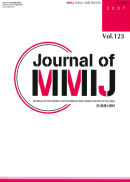123 巻, 12 号
選択された号の論文の69件中1~50を表示しています
第1章 総説
総説
-
2007 年 123 巻 12 号 p. 565-569
発行日: 2007/12/25
公開日: 2010/12/17
PDF形式でダウンロード (1828K) -
2007 年 123 巻 12 号 p. 570-574
発行日: 2007/12/25
公開日: 2010/12/17
PDF形式でダウンロード (2331K) -
2007 年 123 巻 12 号 p. 575-581
発行日: 2007/12/25
公開日: 2010/12/17
PDF形式でダウンロード (2799K) -
2007 年 123 巻 12 号 p. 582-590
発行日: 2007/12/25
公開日: 2010/12/17
PDF形式でダウンロード (1541K) -
2007 年 123 巻 12 号 p. 591-596
発行日: 2007/12/25
公開日: 2010/12/17
PDF形式でダウンロード (2188K)
第2章 非鉄金属製錬プロセスと操業
銅
報告
-
2007 年 123 巻 12 号 p. 597-601
発行日: 2007/12/25
公開日: 2010/12/17
PDF形式でダウンロード (3449K) -
2007 年 123 巻 12 号 p. 602-604
発行日: 2007/12/25
公開日: 2010/12/17
PDF形式でダウンロード (1455K) -
2007 年 123 巻 12 号 p. 605-607
発行日: 2007/12/25
公開日: 2010/12/17
PDF形式でダウンロード (1916K) -
2007 年 123 巻 12 号 p. 608-613
発行日: 2007/12/25
公開日: 2010/12/17
PDF形式でダウンロード (3222K) -
2007 年 123 巻 12 号 p. 614-619
発行日: 2007/12/25
公開日: 2010/12/17
PDF形式でダウンロード (2936K) -
2007 年 123 巻 12 号 p. 620-625
発行日: 2007/12/25
公開日: 2010/12/17
PDF形式でダウンロード (3891K) -
2007 年 123 巻 12 号 p. 626-629
発行日: 2007/12/25
公開日: 2010/12/17
PDF形式でダウンロード (2065K)
鉛・亜鉛
報告
-
2007 年 123 巻 12 号 p. 630-633
発行日: 2007/12/25
公開日: 2010/12/17
PDF形式でダウンロード (1848K) -
2007 年 123 巻 12 号 p. 634-638
発行日: 2007/12/25
公開日: 2010/12/17
PDF形式でダウンロード (2512K) -
2007 年 123 巻 12 号 p. 639-641
発行日: 2007/12/25
公開日: 2010/12/17
PDF形式でダウンロード (1374K) -
2007 年 123 巻 12 号 p. 642-645
発行日: 2007/12/25
公開日: 2010/12/17
PDF形式でダウンロード (1831K) -
2007 年 123 巻 12 号 p. 646-650
発行日: 2007/12/25
公開日: 2010/12/17
PDF形式でダウンロード (1800K) -
2007 年 123 巻 12 号 p. 651-656
発行日: 2007/12/25
公開日: 2010/12/17
PDF形式でダウンロード (2116K) -
2007 年 123 巻 12 号 p. 657-660
発行日: 2007/12/25
公開日: 2010/12/17
PDF形式でダウンロード (2039K) -
2007 年 123 巻 12 号 p. 661-665
発行日: 2007/12/25
公開日: 2010/12/17
PDF形式でダウンロード (2709K) -
2007 年 123 巻 12 号 p. 666-671
発行日: 2007/12/25
公開日: 2010/12/17
PDF形式でダウンロード (2961K)
貴金属
報告
-
2007 年 123 巻 12 号 p. 672-674
発行日: 2007/12/25
公開日: 2010/12/17
PDF形式でダウンロード (1402K) -
2007 年 123 巻 12 号 p. 675-677
発行日: 2007/12/25
公開日: 2010/12/17
PDF形式でダウンロード (1838K)
ニッケル
報告
-
2007 年 123 巻 12 号 p. 678-681
発行日: 2007/12/25
公開日: 2010/12/17
PDF形式でダウンロード (2180K) -
2007 年 123 巻 12 号 p. 682-685
発行日: 2007/12/25
公開日: 2010/12/17
PDF形式でダウンロード (1315K) -
2007 年 123 巻 12 号 p. 686-688
発行日: 2007/12/25
公開日: 2010/12/17
PDF形式でダウンロード (1928K) -
2007 年 123 巻 12 号 p. 689-692
発行日: 2007/12/25
公開日: 2010/12/17
PDF形式でダウンロード (1969K)
諸金属
報告
-
2007 年 123 巻 12 号 p. 693-697
発行日: 2007/12/25
公開日: 2010/12/17
PDF形式でダウンロード (1643K) -
2007 年 123 巻 12 号 p. 698-703
発行日: 2007/12/25
公開日: 2010/12/17
PDF形式でダウンロード (2232K) -
2007 年 123 巻 12 号 p. 704-706
発行日: 2007/12/25
公開日: 2010/12/17
PDF形式でダウンロード (1216K) -
2007 年 123 巻 12 号 p. 707-710
発行日: 2007/12/25
公開日: 2010/12/17
PDF形式でダウンロード (1473K) -
2007 年 123 巻 12 号 p. 711-714
発行日: 2007/12/25
公開日: 2010/12/17
PDF形式でダウンロード (1627K) -
2007 年 123 巻 12 号 p. 715-718
発行日: 2007/12/25
公開日: 2010/12/17
PDF形式でダウンロード (1832K)
第3章 リサイクリング・プロセスと操業
鉛・亜鉛
報告
-
2007 年 123 巻 12 号 p. 719-722
発行日: 2007/12/25
公開日: 2010/12/17
PDF形式でダウンロード (1613K) -
2007 年 123 巻 12 号 p. 723-725
発行日: 2007/12/25
公開日: 2010/12/17
PDF形式でダウンロード (1718K) -
2007 年 123 巻 12 号 p. 726-729
発行日: 2007/12/25
公開日: 2010/12/17
PDF形式でダウンロード (2450K) -
2007 年 123 巻 12 号 p. 730-733
発行日: 2007/12/25
公開日: 2010/12/17
PDF形式でダウンロード (1652K)
貴金属
報告
-
2007 年 123 巻 12 号 p. 734-736
発行日: 2007/12/25
公開日: 2010/12/17
PDF形式でダウンロード (1504K) -
2007 年 123 巻 12 号 p. 737-740
発行日: 2007/12/25
公開日: 2010/12/17
PDF形式でダウンロード (1513K) -
2007 年 123 巻 12 号 p. 741-743
発行日: 2007/12/25
公開日: 2010/12/17
PDF形式でダウンロード (1620K) -
2007 年 123 巻 12 号 p. 744-746
発行日: 2007/12/25
公開日: 2010/12/17
PDF形式でダウンロード (1789K)
諸金属
報告
-
2007 年 123 巻 12 号 p. 747-750
発行日: 2007/12/25
公開日: 2010/12/17
PDF形式でダウンロード (2913K) -
2007 年 123 巻 12 号 p. 751-753
発行日: 2007/12/25
公開日: 2010/12/17
PDF形式でダウンロード (1194K) -
2007 年 123 巻 12 号 p. 754-757
発行日: 2007/12/25
公開日: 2010/12/17
PDF形式でダウンロード (1431K)
再資源化
報告
-
2007 年 123 巻 12 号 p. 758-762
発行日: 2007/12/25
公開日: 2010/12/17
PDF形式でダウンロード (6765K) -
2007 年 123 巻 12 号 p. 763-767
発行日: 2007/12/25
公開日: 2010/12/17
PDF形式でダウンロード (2279K) -
2007 年 123 巻 12 号 p. 768-771
発行日: 2007/12/25
公開日: 2010/12/17
PDF形式でダウンロード (1631K) -
2007 年 123 巻 12 号 p. 772-775
発行日: 2007/12/25
公開日: 2010/12/17
PDF形式でダウンロード (2099K) -
2007 年 123 巻 12 号 p. 776-778
発行日: 2007/12/25
公開日: 2010/12/17
PDF形式でダウンロード (1383K)
第4章 中間処理プロセス・業界の現状と課題
報告
-
2007 年 123 巻 12 号 p. 779-783
発行日: 2007/12/25
公開日: 2010/12/17
PDF形式でダウンロード (2963K)
